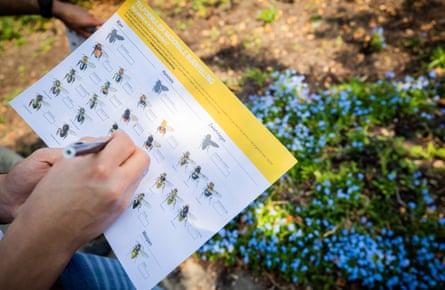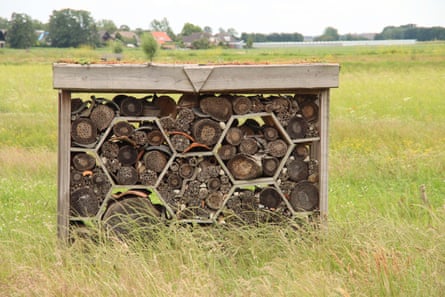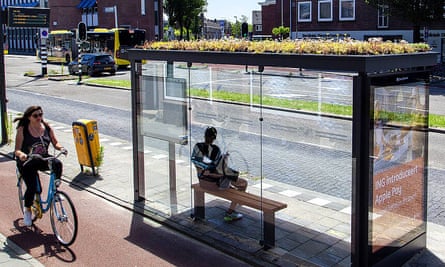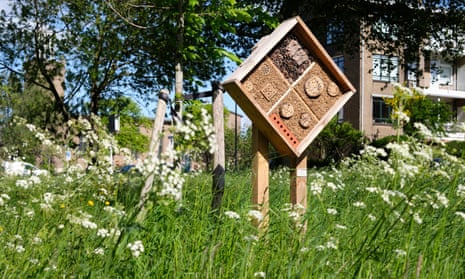Bee hotels, bee stops and a honey highway are some of the techniques the Dutch are crediting with keeping their urban bee population steady in recent years, after a period of worrying decline.
Last week, more than 11,000 people from across the Netherlands participated in a bee-counting exercise as part of the fourth edition of the national bee census.
The enthusiastic volunteers, armed with a list depicting the most common bees at this time of the year, spent 30 minutes in their gardens recording their apian visitors. At the close of data submission on Sunday 18 April, more than 200,000 bees and hoverflies had been counted.
The results – for urban bees at least – were steady. Vincent Kalkman, entomologist at Naturalis, one of the organisations behind the census said: “An average of 18 to 20 bees and hoverflies were recorded in each garden during the count. These numbers have remained steady over the years, indicating that there is no strong decline in urban gardens.”
The census aims to collect five years’ of data before drawing definitive conclusions on bee population trends.

The honeybee (Apis mellifera) was the most spotted bee with more than 55,000 observations while the red mason bee (Osmia bicornis) and the earth bumblebee (Bombus terrestris) came in a distant second and third with about 13,000 and 12,800 records respectively. “The bee census is about gathering data but it is also serves to draw people’s attention to the different kinds of bees visiting their gardens,” said Kalkman. “It [the census] is also about education.”
With more than a quarter of the bees recorded in the 2021 census being honey bees, a species propped up by beekeeping, Kalkman is concerned they could be competing with wild bees for food.
“The increase in the number of beekeepers in cities could result in increased competition for food between honeybees and wild bees,” he said. “We need to work with beekeepers to increase food sources (flowers) for all bees.”
The native wild bee population in the Netherlands has been in decline since the 1940s, a trend that seems to stem predominantly from the agricultural areas of the country. Until 50 years ago, these areas had a myriad variety of wild flowers that sustained healthy bee populations. But the pressure on farmers for increased output, means farmlands no longer have space for nature. Large swathes of agricultural land are almost devoid of wild flowers, leading to the decline in bee numbers, a phenomenon compounded further by the use of harmful pesticides in agriculture.
“The economic importance of agricultural areas makes it difficult to change things there,” said Kalkman. More than half of the Netherlands’ 360 bee species are endangered.

The Netherlands is the world’s second largest exporter of agricultural products, after the US. Recognising the crucial role played by wild bees in the pollination of food crops, especially fruit and vegetable plants, a national pollinator strategy was announced in 2018, to create increased opportunities for “bed and breakfast for bees”. The strategy. signed by 43 government and non-government partners. includes 70 initiatives aimed at creating more nesting sites for bees and strengthening their food supply, in the process enabling nature and agriculture to coexist.
Dutch cities have certainly been doing their bit. Amsterdam has been working on various bee-friendly initiatives that include putting up “bee hotels” (a collection of hollow plant stems or thin bamboo that provides cavities for solitary bees to nest), replacing grass in public spaces with native flowering plants, and stopping the use of chemical weed killers on public lands. Florinda Nieuwenhuis, an ecologist at the municipality of Amsterdam, reported in Ten years of Wild Bee Policy in Amsterdam (March 2021) that a 45% increase in the number of solitary bee species was recorded in the city in 2015, compared with a survey in 2000.
Utrecht has been building bee stops – bus stops with their roofs covered in native plants – that attract bees and absorb dust particles and rainwater. Since 2018, 316 bee stops have been installed.

And Deborah Post has launched Honey Highway, an entrepreneurial venture that collaborates with municipalities to plant wildflowers in the space available on the sides of highways, railways, and waterways, thus ensuring food and shelter for bees.
In view of the rapid urbanisation in the Netherlands, Kalkman said: “The Dutch government aims at building hundreds of thousands of new homes in the coming years. So we have to think of ways in which we can preserve nature alongside the increasing number of cities.”
